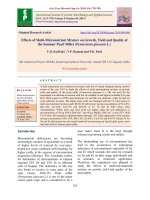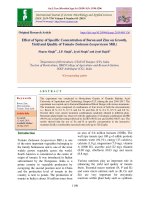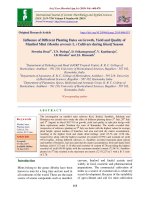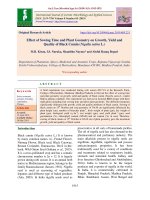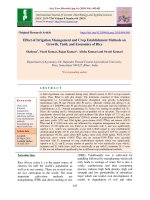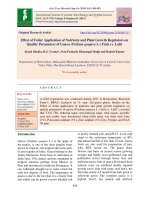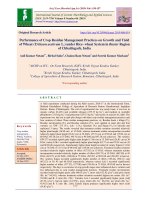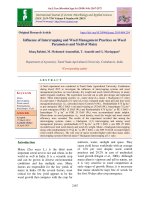Influence of nutrients and shoot retention on growth, yield and fruit characters in rejuvenated guava (Psidium guajava L.) cv. Sardar
Bạn đang xem bản rút gọn của tài liệu. Xem và tải ngay bản đầy đủ của tài liệu tại đây (154.3 KB, 7 trang )
Int.J.Curr.Microbiol.App.Sci (2019) 8(10): 2582-2588
International Journal of Current Microbiology and Applied Sciences
ISSN: 2319-7706 Volume 8 Number 10 (2019)
Journal homepage:
Original Research Article
/>
Influence of Nutrients and Shoot Retention on Growth, Yield and Fruit
Characters in Rejuvenated Guava (Psidium guajava L.) cv. Sardar
S. Archana1*, Nagesh Naik2, K.H. Nataraja3, V. Kantharaju4,
Sayeed Almas Mulla5 and V. Vandana6
1,2,3
Department of Fruit Science, 4Department of Plant pathology, 5Department of Soil
Science, 4Department of SAS, Kittur Rani Channamma College of Horticulture, Arabhavi,
Gokak, Tq. Belagavi, D. Karnataka, India
*Corresponding author
ABSTRACT
Keywords
Guava,
Rejuvenation, Shoot
retention, Nutrients
Article Info
Accepted:
18 September 2019
Available Online:
10 October 2019
A study on the influence of nutrients and shoot retention on growth and yield in
rejuvenated guava was conducted during 2018-2019 in the Department of Fruit Science,
Kittur Rani Channamma College of Horticulture, Arabhavi (UHS, Bagalkot), Karnataka.
Among shoot thinning 3 shoots per branch (S1) recorded maximum plant height (3.16 m),
length of the shoot (132.48 cm), girth of the shoot (3.09 cm), number of leaves per shoot
(76.94), Plant spread (N-S and E-S) (3.30 and 3.44 m), fruit physical parameters viz., Fruit
length (6.48 cm), girth (6.58 cm), weight (162.82 g),number of fruits per plant (69.28),
yield (2.85 t/ha). Nutrient had significant effect on growth and yield parameters in
rejuvenated guava. Plants supplemented with 100 % RDF (200: 80: 150 NPK g/plant) +
(Zn+B+Mg) 0.3 % each (F6) has recorded maximum plant height (3.11 m),length of the
shoot (133.22 cm), girth of the shoot (3.00 cm), number of leaves per shoot (76.00), Plant
spread (N-S and E-S) (3.25 and 3.32 m), fruit physical parameters viz., Fruit length (6.57
cm), girth (6.64 cm), weight(168.64 g), number of fruits per plant (69.14), yield (3.03
t/ha). Interaction effect has got non significant results for all the parameters. However, the
treatment S2F6 consisting of 4 shoots per branch and 100 per cent RDF (200:80:150 NPK
g/plant) + (Zn+B+Mg) 0.3 per cent each has recorded moderate vegetative and fruit
physical parameters and highest leaves per plant (79.67), highest number of fruits per plant
(73.96) and yield (3.30 t/ha) with highest benefit cost ratio of 2.02.
Introduction
Guava (Psidium guajava L.) is one of the most
exquisite and valuable fruit of the tropics and
belongs to the family “Myrtaceae”. It is native
of Tropical America and brought to India by
the Portuguese as early as 17th century. Guava
is considered to be poor man‟s fruit and also
called as apple of tropics which is very
nutritious having vitamin C (75-260 mg/100g
pulp) (Shukla et al., 2008). Fruits are preferred
for fresh consumption as well as different
2582
Int.J.Curr.Microbiol.App.Sci (2019) 8(10): 2582-2588
processed products like jam, jelly, cheese,
nectar etc. All parts of the plant used for
different
medicinal
purposes
viz.,
hepatoprotection,
antioxidant,
antiinflammatory, antispasmodic, anti-cancer,
antimicrobial, anti-hyperglycemic, analgesic,
anti-stomachache and anti-diarrhea (Barbalho
et al., 2012). In order to overcom the problem
of unproductive and uneconomic orchards
existing in abundance, large scale uprooting
and replacement with new plantations
(rehabilitation) is long term and expensive
strategy. The rejuvenation technology
involves the heading back of exhausted trees
(showing marked decline in annual production
and quality of produce) to 1.0 to 1.5-meter
height above the ground level during MayJune or December-February to facilitate the
production of new shoots from below the cut
point and allow the development of fresh
canopy of healthy shoots (Jahangeer et al.,
2011). Pruning helps to balance between
vegetative and reproductive growth of the
plant. The main advantages of pruning on
bearing trees include the formation of new
shoots, avoid overcrowding of branches,
removal of criss-crossed and diseased
branches (Lian et al., 2019). Manipulation of
tree growth using canopy management
practices to control tree growth patterns, tree
shape for high fruit production of desired size
and quality (Singh, 2001). The thinning of
shoots per branch is also one of the canopy
management practices in the rejuvenation of
old orchards (Bhagawati et al., 2015).
Nutrients can be made available to the plants
by the basal as well as foliar application.
Nitrogen, phosphorus and potassium are the
major and essential nutrients required by the
plants in larger quantities. These are
responsible for maximizing physiological
activities of the plant which ultimately affect
the growth, development, fruiting and quality
until the fruits attain physiological maturity
(Nijjar,
1996).
Hence,
the
present
investigation was undertaken to study the
influence of nutrients and shoot retention on
growth, yield in rejuvenated guava cv. Sardar.
Materials and Methods
An experiment was carried out in the fruit
science departmental orchard, the experiment
was laid out in factorial randomized
completely block design (FRCBD) and
replicated thrice as follows. The factor 1
consists of 3 levels of thinning, i.e. retaining
three shoots per branch (S1), four shoots per
branch (S2) and Five shoots per branch (S3).
Shoot thinning was done in the 1st week of
June. Factor 2 consists of 6 different nutrient
levels viz., 50 % RDF (100: 40: 75 NPK
g/plant) + (Zn+B+Mg) 0.2 % each(F1), 50 %
RDF (100: 40: 75 NPK g/plant) + (Zn+B+Mg)
0.3 % each (F2), 75 % RDF (150: 60: 110
NPK g/plant) + (Zn+B+Mg) 0.2 % each (F3),
75 % RDF (150: 60: 110 NPK g/plant) +
(Zn+B+Mg) 0.3 % each (F4), 100 % RDF
(200: 80: 150 NPK g/plant) + (Zn+B+Mg) 0.2
% each (F5), 100 % RDF (200: 80: 150 NPK
g/plant) + (Zn+B+Mg) 0.3 % each (F6).
Recommended doses of fertilizers were
applied on per plant basis according to the
treatment details in two split doses. 50 per
cent of urea was applied in the month of July
as basal dose and the remaining 50 per cent
urea and full dose of single super phosphate
and muriate of potash as top dress applied
during October. Micro nutrients like zinc in
the form of ZnSo4, boron in the form of borax
and magnesium in the form of MgSo4 sprayed
before and after flowering as per the
treatments.
Results and Discussion
The growth parameters were significantly
influenced by different treatments. Plants
retained with 3 shoots per branch had resulted
in maximum plant height (3.16 m), plant girth
(12.01 cm), length of the shoot (132.48 cm),
girth of the shoot (3.09 cm) this may be
2583
Int.J.Curr.Microbiol.App.Sci (2019) 8(10): 2582-2588
attributed to relatively less numbers of shoots
and availability of more nutrients per shoots
under identical condition which is also
reported by Bhagawati et al., (2015) in guava.
In the present study lateral buds are stimulated
to grow (due to better dry matter partitioning)
after pruning due to higher activity of GA-like
substances which can be related to the
findings by Lian et al., (2019) in guava.
Further higher number of leaves per shoot
(76.94) was recorded in 4 shoots per branch
which is due to increased length of shoot with
the increasing pruning severity which was also
reported by Pawan et al., (2017) in mulberry.
Maximum plant spread (N-S and E-W) (3.30
and 3.44 m) canopy volume (11.52 m3) were
recorded in 5 shoots per branch. Since,
pruning remove carbon-starved, fruiting
exhausted shoots and promotes new leaf
growth to build-up carbohydrates reserves for
the next flowering and allows the sprouting of
lateral buds which ultimately influenced the
canopy spread and volume which was reported
by Dhaliwal et al., (2000) and Pilania et al.,
(2010) in guava. Among nutrition F6 has
recorded maximum vegetative parameters viz.,
plant height (3.11 m), plant girth (11.74 cm),
length of the shoot (133.22 cm), girth of the
shoot (3.00 cm), number of leaves per shoot
(76.00), Plant spread (N-S and E-S) (3.25 and
3.32 m) and canopy volume (10.82 m3). This
might be due to the fact that, application of
nitrogen which resulted in vigorous vegetative
growth of the plant and gave the darker green
colour to the foliage. This favoured the
photosynthetic activity of the plants and
greater synthesis of carbohydrates, which led
to the formation of amino acids, nucleoproteins, chlorophyll, alkaloids and amides.
The complex compounds are responsible for
building up of new tissues and are associated
with a number of metabolic processes, which
in turn favour better developments of plants.
The increase in growth as a result of nitrogen
application is obvious. Similarly, increase in
vegetative growth of fruit plants by the
application of nitrogen has also been reported
earlier by Dhomane et al., (2011) and
Dineshkumar et al., (2009) in guava.
Increased vegetative growth by micronutrients
might be due to residual effect of higher
concentration of auxins in plant which
produced high leaf to fruit ratio was an
ultimate cause of higher amount of
photosynthates and has a key role in cell
division and elongation, and there by
increased vegetative growth.
The highest Fruit length (6.48 cm), girth (6.58
cm), weight (162.82 g) and volume (139.53
ml) was recorded in S1. The results are in the
confirmation with Dhaliwal et al., (2000) in
guava, they found that polar diameter of fruit
increased with pruning intensity of guava and
also by Pilania et al., (2010) in guava. The
higher fruit weight and volume in pruned
plants may be due to an improved microclimate and higher photosynthetic rates as the
pruning intensity increases the number of
fruits per plant decreases. So, developing fruit
gets ample of nutrient and plant hormone that
increases fruit size. This may be the reason of
highest fruit weight and volume observed in
severe pruning by Sahoo et al., (2017) in
Sapota. Among the nutrition highest fruit
length (6.57 cm), girth (6.64 cm), weight
(168.64 g) and volume (146.70 ml) was
recorded in F6. The increase in number and
area of leaves increases the amount of
photosynthates that cause a significant
increase in size and weight of fruit. The results
of the present findings are supported from the
findings of Lian et al., (2019) in guava. This is
due to the fact that nitrogen increases the
efficiency of metabolic processes of the plant
and consequently increases the size and
weight of the fruit, another probable cause
could be greater mobility of nutrients to the
developing fruits which act as strong
metabolic sink. Similar results were also
reported by Dineshkumar et al., (2009) in
guava (Table 1 and 2).
2584
Int.J.Curr.Microbiol.App.Sci (2019) 8(10): 2582-2588
Table.1 Estimation of vitamin B-6 (ppm) in Areca nut collected from different locations of
Karnataka
Treatments
Plant
height
(cm)
Shoots retention (S)
3.16
S1
2.89
S2
2.69
S3
S.Em ±
0.06
CD at 5 %
0.16
Nutrition (F)
2.77
F1
2.83
F2
2.87
F3
2.93
F4
2.97
F5
3.11
F6
S.Em ±
0.08
CD at 5 %
0.23
Interactions (S x F)
3.06
S1 F1
3.11
S1 F2
3.13
S1 F3
3.17
S1 F4
3.20
S1 F5
3.29
S1F6
2.70
S2 F1
2.79
S2 F2
2.83
S2 F3
2.91
S2 F4
2.96
S2 F5
3.17
S2 F6
2.55
S3 F1
2.60
S3 F2
2.64
S3 F3
2.71
S3 F4
2.75
S3 F5
2.86
S3 F6
S.Em ±
0.14
CD at 5 %
NS
Plant
stem
girth
(cm)
Length
of the
shoots
(cm)
Girth of
the
shoots
(cm)
Number
of leaves
per
shoots
12.01
11.65
10.43
0.22
NS
132.48
127.02
123.11
1.60
4.60
3.09
2.66
2.47
0.063
0.18
71.07
76.94
71.41
1.31
NS
2.80
3.03
3.30
0.05
0.15
2.80
3.19
3.44
0.05
0.15
8.02
10.08
11.52
0.24
0.69
10.85
11.23
11.32
11.50
11.55
11.74
0.31
0.89
122.94
124.89
126.41
127.57
130.18
133.22
2.26
6.50
2.51
2.63
2.71
2.76
2.84
3.00
0.089
0.25
70.72
71.26
72.28
73.43
75.13
76.00
1.85
5.32
2.84
2.88
2.97
3.10
3.21
3.25
0.08
0.22
2.98
3.06
3.10
3.16
3.25
3.32
0.07
0.21
8.88
9.40
9.75
9.99
10.41
10.82
0.34
0.98
11.02
11.93
11.93
12.23
12.24
12.70
11.44
11.45
11.69
11.76
11.75
11.83
10.08
10.31
10.33
10.49
10.67
10.68
0.54
NS
128.33
130.00
130.83
133.00
135.05
137.67
122.83
124.67
126.39
127.38
128.49
132.33
117.67
120.00
122.00
122.33
127.00
129.67
3.92
NS
2.91
2.97
3.04
3.13
3.20
3.30
2.44
2.58
2.63
2.65
2.73
2.93
2.17
2.34
2.46
2.48
2.59
2.77
0.15
NS
68.50
69.37
70.00
71.13
73.40
74.00
74.67
75.00
76.50
77.49
78.33
79.67
69.00
69.40
70.34
71.68
73.67
74.35
3.21
NS
2.55
2.60
2.77
2.89
2.96
3.02
2.89
2.92
2.93
3.00
3.20
3.23
3.06
3.13
3.20
3.40
3.47
3.50
0.13
NS
2.58
2.67
2.76
2.81
2.97
3.01
3.07
3.13
3.16
3.20
3.25
3.32
3.28
3.37
3.38
3.46
3.54
3.61
0.12
NS
6.92
7.17
7.83
8.20
8.67
9.35
9.54
9.64
9.91
10.17
10.38
10.85
10.18
11.39
11.51
11.61
12.18
12.26
0.59
NS
2585
Plant spread (m)
(North(EastSouth)
West)
Canopy
volume
(m3)
Int.J.Curr.Microbiol.App.Sci (2019) 8(10): 2582-2588
Table.2 Influence of number of shoots and nutrients on yield and yield attributes
in rejuvenated guava
Treatments
Length
(cm)
Shoots retention (S)
6.48
S1
6.29
S2
5.93
S3
S.Em ±
0.08
CD at 5 %
0.22
Nutrition (F)
5.98
F1
6.06
F2
6.14
F3
6.25
F4
6.39
F5
6.57
F6
S.Em ±
0.11
CD at 5 %
0.32
Interactions (S x F)
6.20
S1 F1
6.28
S1 F2
6.29
S1 F3
6.42
S1 F4
6.74
S1 F5
6.95
S1F6
6.08
S2 F1
6.13
S2 F2
6.23
S2 F3
6.35
S2 F4
6.40
S2 F5
6.53
S2 F6
5.66
S3 F1
5.78
S3 F2
5.90
S3 F3
5.97
S3 F4
6.03
S3 F5
6.23
S3 F6
S.Em ±
0.19
CD at 5 %
NS
Fruit
Girth Weight
(cm)
(g)
Volume
(ml)
Number
of fruits
per plant
Yield
(kg/plant)
(t/ha)
B:C
Ratio
6.58
6.38
6.10
0.08
0.24
162.82
157.89
147.98
3.01
8.66
139.53
136.27
123.04
3.07
8.82
61.71
69.28
65.48
0.85
2.45
9.17
10.25
9.23
0.23
0.66
2.55
2.85
2.57
0.064
0.18
-
6.08
6.21
6.28
6.39
6.51
6.64
0.12
0.33
143.59
150.12
152.74
158.26
164.03
168.64
4.26
12.25
123.52
127.48
129.62
131.21
139.14
146.70
4.34
12.47
61.02
63.03
65.43
66.52
67.80
69.14
1.20
3.46
8.31
8.81
9.35
9.73
10.20
10.90
0.33
0.94
2.31
2.45
2.60
2.70
2.83
3.03
0.091
0.26
-
6.30
6.44
6.57
6.63
6.70
6.84
6.14
6.26
6.32
6.39
6.53
6.62
5.80
5.93
5.96
6.13
6.31
6.45
0.20
NS
147.40
154.92
156.01
166.45
175.07
177.08
146.03
149.40
156.45
158.67
166.33
170.43
137.34
146.02
145.77
149.67
150.68
158.40
7.38
NS
129.00
132.22
134.97
136.53
148.33
156.11
128.22
131.11
132.22
134.22
140.75
151.09
113.33
119.11
121.67
122.89
128.33
132.89
7.52
NS
58.73
59.70
61.41
61.83
63.47
65.12
64.13
65.82
68.83
70.48
72.45
73.96
60.18
63.58
66.05
67.24
67.48
68.36
2.08
NS
8.04
8.63
8.93
9.27
9.71
10.41
8.80
9.16
10.09
10.46
11.15
11.87
8.10
8.64
9.03
9.47
9.74
10.42
0.57
NS
2.23
2.40
2.48
2.58
2.70
2.89
2.44
2.55
2.80
2.90
3.10
3.30
2.25
2.40
2.51
2.63
2.71
2.89
0.16
NS
0.61
1.02
1.04
1.42
1.48
1.64
0.77
0.84
1.31
1.38
1.84
2.02
0.63
0.73
0.77
0.85
1.48
1.64
-
2586
Int.J.Curr.Microbiol.App.Sci (2019) 8(10): 2582-2588
The possible reason for increase in fruit
weight by the micronutrients might be due to
faster loading and mobilization of photo
assimilates to fruits and involvement in cell
division and cell expansion which ultimately
reflected into more weight of fruit in treated
pants. Similar results were also found by
Chandra and Singh (2015) in Aonla. The
highest number of fruits per plant (69.28) and
yield (10.25 kg/plant and 2.85 t/ha) was
observed in S2. Pruning facilitates supply of
adequate nutrients to reduced plant parts for
their proper growth and development. Thus,
pruning with appropriate intensity, not only
regulate the canopy size but also leads to
better fruit quality and yield through better
exposure of branches and fruits which was in
accordance with the findings by Bhagawati et
al., (2015) and Camus et al., (2018) in guava.
The analysed results dissipated significant
differences for nutrition. The highest number
of fruits per plant (69.14) and yield (10.90
kg/plant and 3.03 t/ha) was obtained in F6.
This may be due to increased photosynthesis,
better plant growth and dry matter
accumulation in addition to increase in
number of flowers and fruit volume and fruit
weight by Cardoso et al., (2011),
Dineshkumar et al., (2009) in guava.
Micronutrients
improve
physiological
activities and might have improved radial and
polar diameter of fruit which ultimately
increased the yield of fruit. These results are
in conformity with the findings of Kabeel et
al., (2013) in plum. Interaction effect has got
non significant results for all the parameters.
However, the treatment S2F6 consisting of 4
shoots per branch and 100 per cent RDF
(200:80:150 NPK g/plant) + (Zn+B+Mg) 0.3
per cent each has recorded moderate
vegetative, fruit physical parameters and with
highest leaves per plant (79.67), highest
number of fruits per plant (73.96) and yield
(11.87 kg/plant and 3.30 t /ha). The data on
cost of cultivation calculated per hectare basis
revealed that the treatment combination of
S2F6 has result the highest benefit cost ratio of
2.02. These reports are in line with the
findings of Pilania et al., (2010) in guava.
In conclusion, plants with 3 shoots per branch
have highest vegetative growth viz., plant
height, plant girth, length and girth of the
shoot. Higher number of leaves per shoot was
noticed in moderately (4 shoots/branch)
thinned plants and plants with 5 shoots per
branch had higher canopy spread and volume.
Plants received with 100 per cent RDF
(200:80:150 NPK g/plant) + (Zn+B+Mg) 0.3
per cent each has maximum growth and yield
parameters. Retaining of 4 shoots per branch
along with application of 100 per cent RDF
(200:80:150 NPK g/plant) + (Zn+B+Mg) 0.3
per cent each is better for higher yield with
highest benefit cost ratio of 2.02 in
rejuvenated guava.
References
Barbalho, S. M., Flavia, M. V., Machado, F.,
Goulart, R. D. A., Brunnati, A. C. S.,
Ottoboni, A. M. M. B. and Nicolau, C.
C. T., 2012, Psidium guajava (Guava):
A Plant of Multipurpose Medicinal
Applications. MAP an open Access
Journal, 1:4 />2167-0412.1000104.
Bhagawati, R., Bhagawati, K., Choudhary, V.
K., Rajkhowa, D. J. and Sharma, R.,
2015, Effect of Pruning Intensities on
the Performance of Fruit Plants under
Mid-Hill
Condition
of
Eastern
Himalayas. Int. Letters of Natural Sci.,
46(1): 46-51.
Camus, D. D., Chinchmalatpure, A. R.,
Kumar, S., Prasad, I. and Vibhute, S.,
2018, Pruning, irrigation and nitrogen
interactions on guava yield and quality
in saline vertisols. J. Soil Salin. Water
Qual., 10(2): 212-217.
Cardoso, E., Costa, de A., Soares, J. T. A.,
2587
Int.J.Curr.Microbiol.App.Sci (2019) 8(10): 2582-2588
Silva, I. S., Da, R. M. and Maracaja P.
B., 2011, Productivity of guava 'Paluma'
for each of mineral fertilization. Revista
Verde de Agroecologiae desenvolvimento Sustentavel, 6(2): 149-153.
Chandra, R. and Singh, K. K., 2015, Foliar
application of zinc sulphate, magnesium
sulphate and copper sulphate on the
yield and quality of aonla (Emblica
officinallis Gaerth L.) cv. “NA-7” under
Garhwal Himalayas. J. Medicinal
Plants Studies, 3(5): 42-45.
Dhaliwal, G. S., Rattanpal, H. S. and Gill, H.
S., 2000, Effect of time and severity of
pruning on cropping and physicochemical properties of „Sardar‟ guava.
Haryana J. Hort. Sci., 29: 20–27.
Dhomane, P. A., Kadam, A. S., Lakade, S. K.
and Gharge, V. R., 2011, Effect of
different sources of nitrogen on growth
and yield of guava cv. Sardar. Asian J.
Hort., 6(1): 92-95.
Dineshkumar, V., Pandey, K., Anjaneyulu
and Vishal Nath, 2009, Optimization of
major nutrients for guava yield and
quality under East coastal conditions.
Indian J. Hort., 66 (1): 18-21.
Jahangeer, A., Baba, P., Akbar, I. and Kumar,
V., 2011, Rejuvenation of old and senile
orchards: A review. Ann. Hort., 4(1):
37-44.
Kabeel, H., Somia, A., Fawaz, E. A., Ismail
and Khalaf, A. F. A., 2013, Effect of
calcium and boron foliar spray on fruit
quality and leaf nutritional status of
"Kelsey" plum trees Egypt. J. Hort.,
40(1): 19-36.
Lian, H. N., Singh, B., Senjam, B. D. and
Ramjan, M., 2019, Effect of shoot
pruning on growth and yield of guava
(Psidium guajava L.) cv. L-49 under
foothills of Arunachal Pradesh. Int. J.
Curr. Microbiol. App. Sci., 8(3): 20202027.
Nijjar, G S., 1996, Nutrition of fruit trees.
Kalyani publishers, New Delhi,
Ludhiana, pp. 6-9.
Pawan, S. J. R., Satpal, B., Surinder, S. and
Mukesh, K., 2017, Effect of the time
and severity of pruning on growth, yield
and quality in mulberry (Morus alba
L.). Int. J. Agri. Sci., 9(50): 4861-4863.
Pilania, S., Shukla, A. K., Maheswar, L. N.,
Sharma, R. and Bairwa., H. L., 2010,
Standardization of pruning intensity and
integrated nutrient management in
meadow orcharding of guava (Psidium
guajava). Indian J. Agri. Sci.,
80(8):673-678.
Sahoo, A. K., Tarai, R. K., Dash, D. K.,
Shinde, G. S. and Bhusan, L. P., 2017,
Effect of different level of pruning on
growth, yield and fruit quality of sapota
cv. Cricket ball under coastal zone of
Odisha. Int. J. Chem. Studies, 5(6):
2157-2160.
Shukla, A.K., Kaushik, R.A., Devendra, P.
and Sarolia, D. K., 2008, Guava
technical bulletin No.1. Communication
centre, Directorate of extension
education. MPUAT, Udaipur, p-1.
Singh, G., 2001, High density planting in
guava. Annual Report, Central Institute
of Subtropical Horticulture, Lucknow.
How to cite this article:
Archana, S., Nagesh Naik, K.H. Nataraja, V. Kantharaju, Sayeed Almas Mulla and Vandana,
V. 2019. Influence of Nutrients and Shoot Retention on Growth, Yield and Fruit Characters in
Rejuvenated Guava (Psidium guajava L.) cv. Sardar. Int.J.Curr.Microbiol.App.Sci. 8(10):
2582-2588. doi: />
2588

